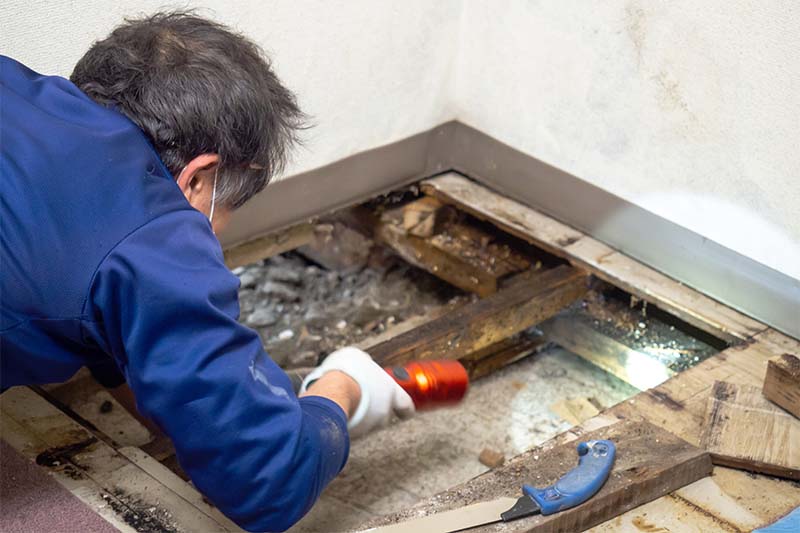Note :
It's important to take your time and do the job right while removing black mould. Eliminating it should be a top concern because of the harm it may do to your house and to your family's health.
The health problems that black mould is known to create should convince you of the necessity of removing it. Allergic reactions include sneezing, congestion, itchy eyes and skin, and hives. Extreme reactions can include things like the flu, hay fever, and difficulty breathing. There is a higher risk of fungal and secondary infections among the young, the elderly, and those with impaired immune systems.
If you suspect mould growth, the first step is to pinpoint the affected area and have it tested. To answer the question, "Do I have a black mould problem?" for oneself, there are a number of available test kits. A tool that tests for airborne spores can provide an answer if there is no visible sign of a problem.
It is general knowledge that black mould thrives in damp environments like restrooms, basements, and crawl spaces. Because of the increased relative humidity found there, mould thrives in certain locations. Mold can develop in any damp environment, including on tile and cement, but it is most commonly seen in porous building materials like sheetrock, carpet, wood, ceiling tiles, etc.
In most cases, a bleach solution is all that's needed to get rid of a little outbreak. In most cases, a solution of 1 cup of bleach to 1 gallon of water will be sufficient to kill mould and remove it from small areas. Cleaning products designed for mould are also commercially available. When using any kind of chemical cleaner, it's crucial to strictly adhere to the manufacturer's instructions. In addition to the aforementioned, you should safeguard yourself from mould by donning a pair of rubber gloves, goggles, and a face mask that seals off the nose and mouth.
Before beginning the cleaning process, make sure the area has adequate ventilation. Allow fresh air to enter the space by opening nearby doors and windows, and consider using a fan to push stale air outside. Turn off the air conditioning and heating as well. Spores won't be able to travel as easily from room to room in the residence.
To get rid of black mould, wash the affected area with bleach or another cleaning solution and let it dry completely before proceeding. After the area has dried, use a HEPA-filtered vacuum to remove any lingering spores that may have been missed during the cleaning process.
Unfortunately, it may require more time, money, and effort to remove mould from greater areas. It may be best to employ a professional remediation agency in this scenario to make sure the task is done right. If the mould has spread far, it may be necessary to remove and replace structural elements such as walls, framing, and flooring.
No one wants mould growing inside their home. Whenever there is cause for concern that black mould may be present in your house, an inspection and cleanup must begin immediately. It's important for the well-being of your household as a whole.
Mold Growth in Your Home: Why It Happens and What to Do for Mold Removal
Mold is a frequent problem that can arise in practically any indoor environment. Mold spores, which are microscopic and nearly invisible, can find their way indoors if they are carried by the wind and settle on a damp surface. Mold can't grow without water or moisture, so if you see it, that's the first thing you should fix. In order to prevent any health issues that may be related to mould, prompt action must be taken once mould growth is discovered. But knowing how to avoid this problem in the future is just as crucial.
Mold thrives in damp environments, so it's important to dry any water leaks or spills right once to prevent the fungus from taking hold. Water and mould problems can be avoided if you keep an eye on a few key trouble spots in your home. Humidity can cause problems with your roof's gutters, your foundation, your air conditioner's drip pans, your walls, pipes, and even your windows. Condensation on windows, walls, and other surfaces may indicate high humidity, a key component in mold's ability to flourish in a given environment.
Health issues, such as allergic reactions, asthma attacks, or eye and skin irritation, are possible due to moulds since they create allergens, irritants, and occasionally even very toxic compounds. As a result, it's crucial to act swiftly if you find mould developing on a surface in your home or business, such as getting in touch with a mould removal service.
Most experts agree that you can probably handle the mould removal on your own if the affected area is smaller than roughly 10 square feet. In any case, if you find mould in a sizable area, or if you are uncertain as to the level of contamination, it is best to have a professional agency handle the cleanup. Hiring a mould removal service is the next logical step.
A remediation firm can dispatch a mould expert to inspect the area in question, make recommendations for how to best remove the mould, clean up the affected area, and ensure that the issue doesn't come back. Because mould growth might pose health risks, it's important to hire a mould remediation service that has extensive experience in the industry. An professional will know what equipment and chemicals to use to completely eradicate the mould, which afflicted things can be recovered, and how to prevent future outbreaks. By fixing the leak or removing the source of the excess moisture, mould development can be stopped in its tracks. The mould removal service you hire should help you fix this.
 Agriculture & Food
Agriculture & Food
 Business Services
Business Services
 Electronics, IT and Telecoms
Electronics, IT and Telecoms
 Leisure & Tourism
Leisure & Tourism
 Minerals
Minerals
 Textiles, Clothing, Leather,
Textiles, Clothing, Leather,
 Transport & Logistics
Transport & Logistics









